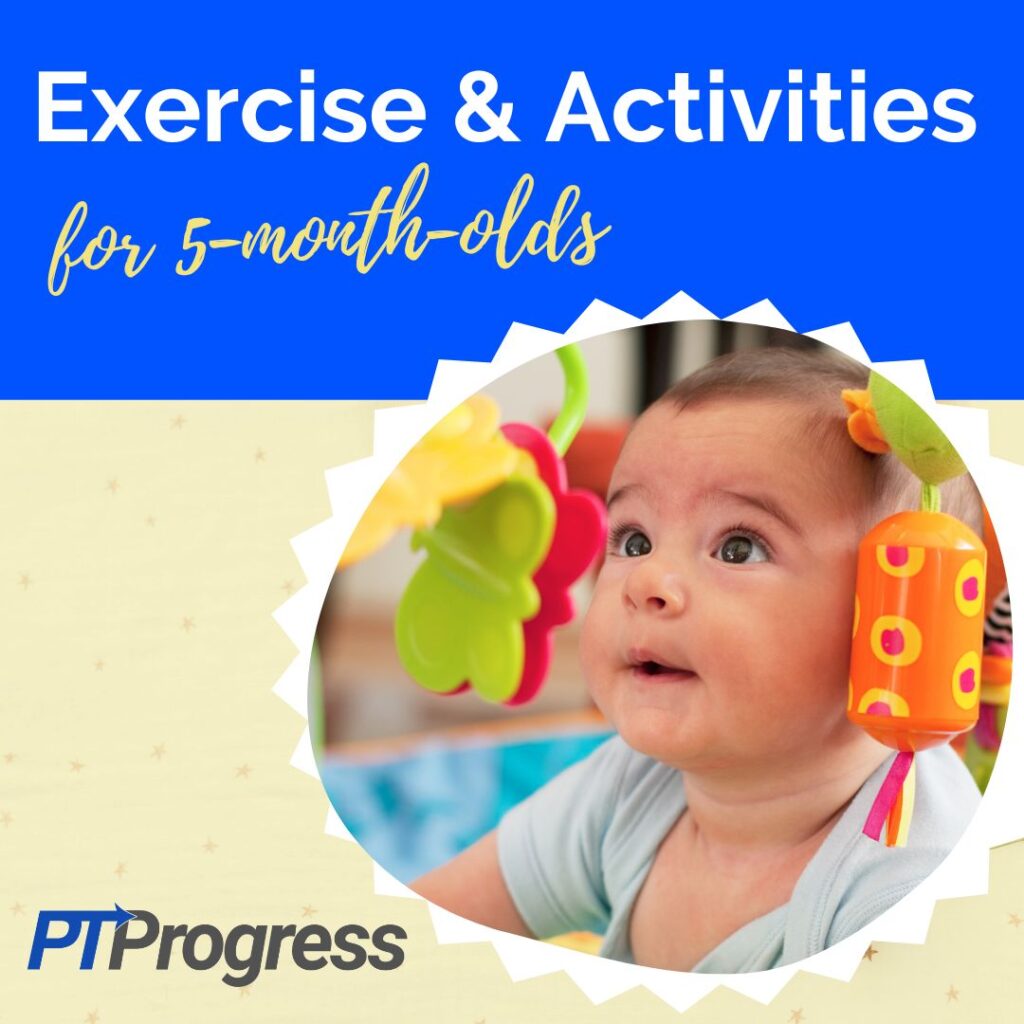
It’s never too early to start exercising. Even your 5-month-old baby can benefit from the following exercises and activities, as recommended by a pediatric occupational therapist!
Introduction
With rolls, head turns, and press-ups, your 5-month-old is exploring the world more actively than ever. At this stage, they may demonstrate impressive strength as they push up from the ground or roll from front to back. Those little legs may seem to be in perpetual motion as your baby learns to kick their feet—turning diaper changes into even more of a challenge!
Your baby is on the cusp of developing much greater mobility, but you can encourage this development by giving them appropriate activities throughout the day. Below are 8 ways to engage a 5-month-old with activities and exercise.
8 Exercises and Activities for 5-Month-Old
As you consider each exercise, remember that every baby reaches milestones at different times. Do only what feels comfortable for you and your baby!
1. Rolling
At five months old, your baby may be able to roll from back to tummy, even if it’s not consistently every day. Don’t be surprised if they are initially successful but later struggle to perform the same task the following week. Learning new skills takes time, and it’s easy for babies to become frustrated.
You can help your baby master this skill with the following activities:
- Lay your baby on their side and place toys in front of them. If they need help staying in this position, place a rolled blanket/towel behind their back or stabilize them with your hands.
- Tuck a rolled-up towel or blanket underneath your baby’s hips. This will help them lift their legs and roll more easily.
- Place toys diagonally above and behind your baby. When they turn their head to look at the toys, their body may follow, resulting in a roll.
2. Supported Sitting
At this age, your child may have decent trunk strength for sitting but still require support to stay upright. Supported sitting is an excellent activity to help strengthen and coordinate all those tiny trunk muscles!
Here are some ways to play in this position:
- Sit with your baby in front of you and place a toy on either side of them, switching sides every 10 seconds. The movement will encourage your baby to use the muscles along their back, neck, and abdominals to stay upright and focused in a seated position.
- Prop up a mirror in front of your baby while they’re sitting on the floor. They will love looking at themselves and will be more likely to sustain the seated position longer. To keep them interested, make faces in the mirror and see if they copy you!
*You may be familiar with baby floor seats, but it’s recommended to practice sitting your baby right on the floor instead of in a seat. Sitting on the floor requires engaging the core muscles to stay upright. When sitting in a seat, your child will be more likely to sit with a rounded back position instead of in an upright position. Granted, baby seats can be of some help—you won’t always be available to sit on the floor and play with your baby all day long. It’s fine to place your baby in a floor seat while you get ready for the day, fold laundry, or make dinner. Just try to limit their time in it and be sure to include some floor time as often as you can!
3. Reaching and Tracking
You’ll notice your baby increasingly reaching and tracking, but these skills have only just begun! Mastering such milestones will pave the way for eating, getting dressed, and other daily life skills. By working on dexterity, grip strength, and coordination, you can help promote your baby’s development in reaching and tracking!
Here’s are some activities and exercises to help this along:
- Have your baby perform supine reaches. Place them on their back and hang a soft toy directly above their midline, within reach. You can move the toy to the right or left to encourage the isolated use of each arm, but you also want them to reach with both hands to develop bilateral coordination.
- You can also encourage reaching and tracking by slowly moving a toy from right to left above their body while they are in this supine position. Reaching for an object in motion helps develop visual tracking skills as well as motor skills.
- For a fun, interactive version of this activity, make yourself the object your baby reaches for! Wear a hooded sweatshirt and lean over your baby so the drawstrings dangle above them. This simple game helps you directly engage with your child while they develop their reaching and tracking skills.
4. Tummy Time Activities for 5-Month-Old
Tummy time is one of the most important ways to play with your baby! Lying on their tummy helps your baby develop muscles in their back, core, neck, hips, arms, and more. Although your baby may dislike tummy time at first, they may start to enjoy it much more, especially as they get better at rolling.
There are a myriad of activities you can do with your baby in tummy time, such as the following:
- Lay your baby in front of a mirror on the floor. When they lift up their head, they’ll be rewarded with a view of themselves. You can lie next to your baby and make faces in the mirror to keep them engaged!
- Place toys in front of your baby while they’re lying on their tummy. If your baby has difficulty using their hands in this play position, you can place a rolled blanket or towel beneath their chest. That will take some of the weight off their hands so they can use them to play.
- Lie on your tummy, face to face with your baby so they can see you. Make funny faces, talk or sing to them, or play with toys on the ground in front of you. When tummy time includes you, your baby may feel more inclined to stay in the position for longer!
5. Sensory Play Activities for 5-Month-Old
We encounter so many different sensations every day: smells, textures, temperatures, sounds, flavors, and sights. Sensory play helps introduce your baby to the variety of sensations that make up the world we live in. You can help your baby explore that world with the following activities:
- Water play can be done all kinds of ways, such as filling a baking sheet with water in front of your baby while they lie on their tummy. You can also purchase a water mat or play with them during bath time! *With all water play, be sure to supervise your baby at all times.*
- Crinkle toys introduce different sounds and textures to your baby. There are many different kinds from which to choose, such as mats, balls, stuffed animals, teethers, mittens, etc. For a simple, DIY crinkle toy, place tissue paper under your baby’s feet. They’ll hear the sound whenever they kick their legs, which they probably do very often at this age!
- Rattles or other noise-making toys can encourage reaching and tracking skills, but they also have the added benefit of creating noise! Playing with toys that make sounds can greatly benefit a baby’s motor and speech development.
- Listening to music or singing to your baby can also improve their speech development. Plus, many kids’ songs are associated with fun movements to target motor development, too. For example, “Head, Shoulders, Knees, and Toes” or “The Wheels On the Bus” are two super-fun songs for singing and dancing!
*Lovevery is a toy subscription company that delivers age-appropriate toys for your baby every couple of months. Included in each box is a guide on how to play with each toy. There are some fantastic sensory toys included in this service, many of which are pictured throughout this guide! “Spinning Rainbow ” and “Socks with Bells” are some favorites for our model, Jack!
6. Supervised Eating
Exploring solid foods can make for a fun time with a five-month-old. Just be sure to exercise plenty of patience as you introduce new foods and textures. As a developmental task, supervised eating can address many different skills, such as upright posture, head control, visual tracking, motor control, and tactile learning.
Let your baby play with their spoon but also practice holding it and bringing it to their mouth. And don’t be afraid to let your baby get messy! Getting messy helps them explore the sensation of touch, and it can even increase the number of foods they try.
7. Reading Books
Reading with your baby is one of the best ways to help them develop language skills. For this age, choose books that have interactive components, such as textures, mirrors, or flaps. Your baby may want to chew on the books, so be sure to give them age-appropriate board books, cloth books, or indestructible books.
8. Standing and Dancing
Supporting your baby in standing and dancing is fun for everyone, and it works on building strength in their legs! Like with many other activities discussed, doing this in front of a mirror can pique your baby’s interest and make it even more fun. Put on some upbeat music or sing to your baby for some personalized interaction!
While you support your baby upright, you may feel them bounce up and down. These natural movements help stretch out their hip muscles and strengthen their legs. Make sure you hold them around their trunk—not just their arms—to ensure they have enough support.
Exercises and Activities for 5-Month-Old: Summary
From bathing and eating to dancing and playing, there are countless ways to incorporate fun activities that spur your five-month-old’s development. You may be surprised how quickly they take to these games and how fast they grow as a result!

